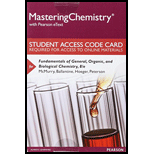
(i)
Interpretation:
The atoms expect to form diatomic molecules has to be identified from the given atoms.
Concept introduction:
Diatomic molecules are formed by the bonding between same atoms.
Covalent bond is formed when electrons are shared between atoms to form a bond. When the electronegativity between two atoms is similar, sharing of electron in the bond is equal and is called nonpolar molecules.
(ii)
Interpretation:
The atoms expect to form mainly covalent bonds has to be identified from the given atoms.
Concept introduction:
Diatomic molecules are formed by the bonding between same atoms.
Covalent bond is formed when electrons are shared between atoms to form a bond. When the electronegativity between two atoms is similar, sharing of electron in the bond is equal and is called nonpolar molecules.
The polarity of a bond is arises due to the difference in electronegativity of atoms present in that bonding.
(iii)
Interpretation:
The atoms expect to form mainly ionic bonds has to be identified from the given atoms.
Concept introduction:
Diatomic molecules are formed by the bonding between same atoms.
Ionic bond or ionic nature of covalent bond is due to the polarity of the bond. Ionic bond takes place between a metal and a nonmetal where ions having opposite charges are held by electrostatic attraction.
The polarity of a bond is arises due to the difference in electronegativity of atoms present in that bonding.
(iv)
Interpretation:
The atoms expect to form both covalent and ionic bonds have to be identified from the given atoms.
Concept introduction:
Diatomic molecules are formed by the bonding between same atoms.
Covalent bond is formed when electrons are shared between atoms to form a bond. When the electronegativity between two atoms is similar, sharing of electron in the bond is equal and is called nonpolar molecules.
Ionic bond or ionic nature of covalent bond is due to the polarity of the bond. Ionic bond takes place between a metal and a nonmetal where ions having opposite charges are held by electrostatic attraction.
The polarity of a bond is arises due to the difference in electronegativity of atoms present in that bonding.
Want to see the full answer?
Check out a sample textbook solution
Chapter 4 Solutions
Mastering Chemistry with Pearson eText -- Standalone Access Card -- for Fundamentals of General, Organic, and Biological Chemistry (8th Edition)
- How many electrons are in the outer shell of each of the following atoms?arrow_forwardWhat enables a radioisotope to substitute for an ordinary (nonradioactive) atom of the same element molecule?arrow_forwardMagnesium has an atomic number of 12. Which of the following statements is true of a neutral magnesium atom? a. It has 12 protons, 12 electrons, and 12 neutrons. b. It has 12 protons, 12 electrons, and six neutrons. c. It has six protons, six electrons, and no neutrons. d. It has six protons, six electrons, and six neutrons.arrow_forward
- What is the smallest unit of an element that retains the properties of that element?arrow_forwardWhich electron shell is the valence shell of an atom, and what is its significance?arrow_forwardWhat is the difference between molecular mass and formula mass? Between molecular mass and molar mass?arrow_forward
- Which are the Major Elements: 99.3% of Total Atoms in the Body?arrow_forwardWhen two atoms share a pair of valence electrons with different levels of electronegativity, what type of bond is this?arrow_forwardif 10 magnesium atoms and 10 chlorine atoms were allowed to bump into each other, could they combine to form a substance? How many molecules made? Would there be any atoms left over? Which ones? How many?arrow_forward
- How does the atomic structure or composition of the versions of sodium in question C above differ from a typical sodium atom, with its atomic mass of 23?arrow_forwardA carbon atom contains six protons and six neutrons.A. What are its atomic number and atomic weight?B. How many electrons does it have?C. How many additional electrons must it add to fill its outermost shell? How does this affect carbon’s chemical behavior?D. Carbon with an atomic weight of 14 is radioactive. How does it differ in structure from nonradioactive carbon? How does this difference affect its chemical behavior?arrow_forwardWhich element is likely to lose an electron more easily, Mg or S?arrow_forward
 Concepts of BiologyBiologyISBN:9781938168116Author:Samantha Fowler, Rebecca Roush, James WisePublisher:OpenStax College
Concepts of BiologyBiologyISBN:9781938168116Author:Samantha Fowler, Rebecca Roush, James WisePublisher:OpenStax College Principles Of Radiographic Imaging: An Art And A ...Health & NutritionISBN:9781337711067Author:Richard R. Carlton, Arlene M. Adler, Vesna BalacPublisher:Cengage Learning
Principles Of Radiographic Imaging: An Art And A ...Health & NutritionISBN:9781337711067Author:Richard R. Carlton, Arlene M. Adler, Vesna BalacPublisher:Cengage Learning Biology (MindTap Course List)BiologyISBN:9781337392938Author:Eldra Solomon, Charles Martin, Diana W. Martin, Linda R. BergPublisher:Cengage Learning
Biology (MindTap Course List)BiologyISBN:9781337392938Author:Eldra Solomon, Charles Martin, Diana W. Martin, Linda R. BergPublisher:Cengage Learning


